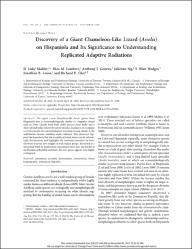/admin/item?itemID=925e415b-3874-4db8-af69-41e454c754bb
Discovery of a giant chameleon-like lizard (Anolis) on Hispaniola and its significance to understanding replicated adaptive radiations

Ver/
Tipo de acceso
AbiertoTipo de Material
ArtículoTipo de Contenido
Investigación científicaMateria
Biodiversidad - República DominicanaFauna ─ República Dominicana
Hábitats y especies
Especies amenazadas o en peligro de extinción
Idioma
InglésAudiencia
Técnicos, profesionales y científicosColección
- Investigación ambiental [1761]
Metadatos
Mostrar el registro completo del ítem| Sinopsis: | We report a new chameleon-like Anolis species from Hispaniola that is ecomorphologically similar to congeners found only on Cuba. Lizards from both clades possess short limbs and a short tail and utilize relatively narrow perches, leading us to recognize a novel example of ecomorphological matching among islands in the well-known Greater Antillean anole radiation. This discovery supports the hypothesis that the assembly of island faunas can be substantially deterministic and highlights the continued potential for basic discovery to reveal new insights in well-studied groups. Restricted to a threatened band of midelevation transitional forest near the border of the Dominican Republic and Haiti, this new species appears to be highly endangered. |
| Autor(es): | Mahler, D. Luke
Lambert, Shea M. Geneva, Anthony J. Ng, Julienne Hedges, S. Blair Losos, Jonathan B. Glor, Richard E. |
| Año: | 2016 |
| Publicado: | The American Naturalist, 188(3), 357-364 |
| Citación: | Mahler, D. L., Lambert, S. M., Geneva, A. J., Ng, J., Hedges, S. B., Losos, J. B., & Glor, R. E. (2016). Discovery of a giant chameleon-like lizard (Anolis) on Hispaniola and its significance to understanding replicated adaptive radiations. The American Naturalist, 188(3), 357-364. Recuperado de: |
| URI: | https://bvearmb.do/handle/123456789/3908
|

